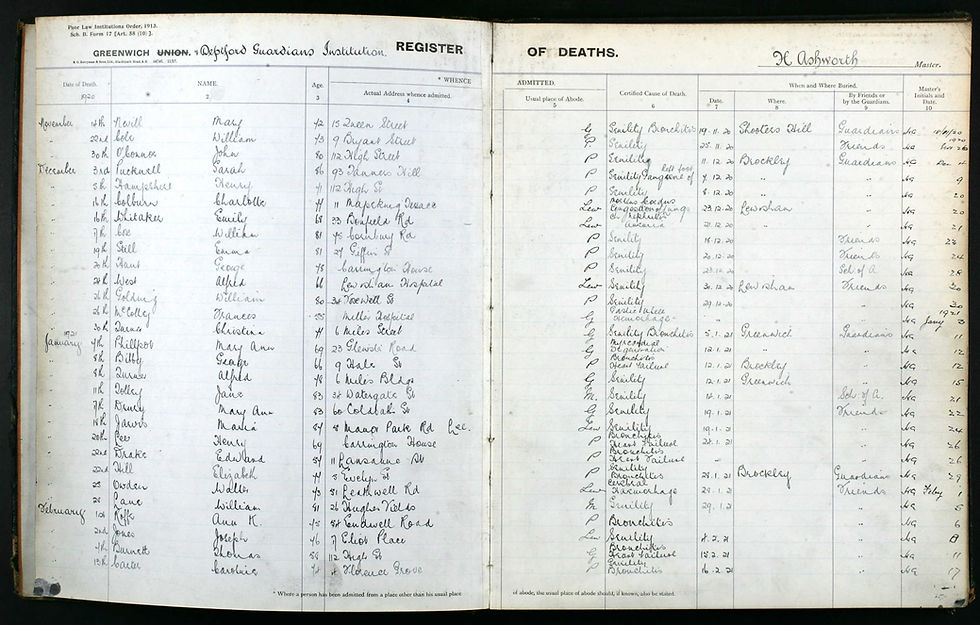In Search Of Maria Vaughan (1832-1921)
- Mark Jarvis
- May 30, 2017
- 3 min read
My great great grandmother was born Maria Vaughan on November 10th 1832 in Limehouse in the East End of London. A month later on December 16th she was baptized at St. Anne’s Church in Limehouse. Her father, Thomas Bundy Vaughan, was a boat builder who worked at Limekiln Dock in Limehouse, and her mother was Eliza Aldridge. Both her parents were originally from a little town in Hampshire called Fawley, but the boom in shipbuilding on the Thames had brought them to the East End of London. Maria was the second youngest of six children that the Vaughan family had.
Maria Vaughan married my great great grandfather, Charles Robert Owen Jarvis, on 6th March 1853. She was 6 months pregnant at the time. You might think that was rather scandalous for the time, but it was much more common than you have been led to believe. It was estimated that in the mid 19th century, a third of Victorian brides went to the altar pregnant, marriage being a consequence of getting pregnant. Some unlucky women were abandoned once they became pregnant - 8% of all births had no father listed on the birth certificate. But in Maria’s case, she married the father of her unborn child.
Maria proceeded to produce nine children with Charles in the following 23 years. Seven of those made it to adulthood. The two that died were Elizabeth Christiana Ann Jarvis who succumbed to the cholera outbreak of 1866 and Charles Benjamin Jarvis who died at the age of 3 after 12 hours of convulsions. With child mortality in the East End of around 25% by age one, Maria and Charles were extremely successful in bringing their children to adulthood - the most likely reason for that is Charles was skilled and earned sufficient money to provide for his family.
In 1878, having seen the decline of shipbuilding on the river Thames, Maria moved to Middlesbrough with my great great grandfather when he took a job working as a Shipwright Surveyor for the Board Of Trade. All seven of her surviving children came along too, and once settled in Middlesbrough, they all married local people and settled into having families. Ten years later, on Christmas Day 1887, Charles died of pneumonia, leaving her 175 pounds and 8 shillings in his will - a small fortune for those days.
After her husband’s death, Maria remained in Middlesbrough until around 1897, when she returned to London with many of her now-married children. The lure of London had clearly attracted her back. There she settled in Lewisham, living with her daughter Maria who had married John Wood Hopps in 1881. In 1911, she appears on the census as a 78 year old mother in law, living with Maria and John Hopps at 14 South Vale in Blackheath. She is described as an "old age pensioner" - the first record of that term that I find in my family.
It was between 1911 and 1920 that Maria became senile and was ultimately moved into an old people’s home called the Deptford Guardian’s Institution. I didn’t find any historical information about that place, but my understanding is that it was a charitable place for old people without the financial means to support themselves.
Maria died aged 88 on January 18th 1921. Her death certificate notes her death as a result of senility. She was buried in Ladywell Cemetery on January 24th in a pauper’s grave.

On May 17th 2017, I took the Docklands Light Railway from Greenwich south to Lewisham and then caught the bus to Ladywell Cemetery.

Although I was not expecting to find a grave, I did want to pay my respects to the place where she is buried. On arrival, I followed my map until I got to the rough location of her grave. Maria is buried in grave D/2568 with 21 other people.

The area of her burial had a number of gravestones which had recently had the overgrown grass removed from them. Many of the inscriptions were no longer readable due to the age of the gravestones themselves. I walked around the border of her burial area, looking at each and every gravestone in the unlikely hope that there would indeed be a memorial to her, but I had no luck. The majority of people buried here were given no headstone and buried in the centre of the plot, so that was where I walked next. It was impossible to know exactly which grave was Maria’s, but she is buried in a peaceful place - the photograph below shows her likely resting place, in the thick grass.

I find it very hard to come to terms with how she would have died a pauper, or how she would have ended up in an institution that looked after old people who had no means by which to support themselves. But that was her reality.




Comments